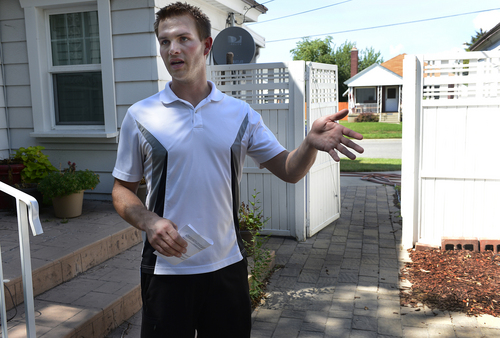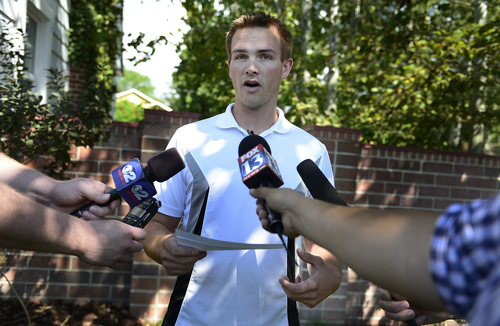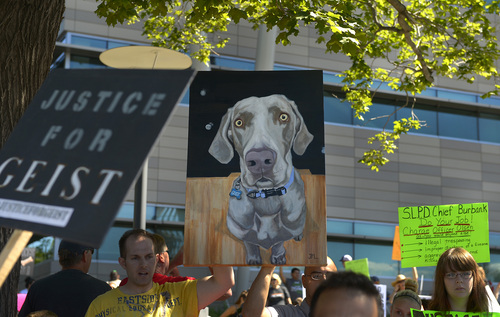This is an archived article that was published on sltrib.com in 2014, and information in the article may be outdated. It is provided only for personal research purposes and may not be reprinted.
The Salt Lake City Police Department said Friday that a police officer "acted within policy" when he shot a dog in its own fenced backyard last month during a search for a missing 3-year-old boy.
Officer Brett Olsen reasonably believed deadly force was necessary to protect himself from being killed or seriously injured by the dog, a Weimaraner named Geist, according to the police department.
The results of the department's Internal Affairs investigation are similar to those released Friday by the independent Civilian Review Board, which exonerated Olsen for the complaint of excessive force the dog's owner lodged against him.
The dog's owner, Sean Kendall, maintains that Olsen entered his fenced back yard illegally and has vowed to pursue legal action against the department.
"It was with great disappointment the Salt Lake City Police Department has chosen to toe the thin blue line instead of uphold their oath to the sovereign country and state they are employed by," Kendall told reporters who gathered at his Sugar House home Friday afternoon.
"When Brett Olsen opened my gate, he violated my constitutionally protected right to privacy, and he then illegally seized and killed Geist," Kendall said.
Olsen shot Geist on June 18 during a search for a missing boy, who was later found asleep in his own basement.
The police department has received hundreds of emails asking for Olsen's termination, and rallies have been held outside police headquarters and in front of the Utah Capitol.
The review board report says it found Olsen was authorized to enter the yard under the "exigent circumstances" exception to obtaining a search warrant, and that Olsen feared for his safety when he shot Geist.
"… the issue is simply: were [Olsen's] actions, based upon what he knew at that time, reasonable and within the law and policy on the use of deadly force?" the board wrote in its report.
The review board report noted Olsen had helped search for Destiny Norton, the 5-year-old girl who disappeared in Salt Lake City in 2006. She was found eight days later murdered in her neighbor's basement. The report said Olsen worried that the longer the boy was missing, the more likely a similar scenario would occur.
So Olsen entered the yard without a warrant, but under what he considered to be exigent circumstances — scenarios recognized by the courts under which police can search to eliminate immediate threats. Olsen had been told the boy did not respond when people talked to him, so Olsen did not call for him.
Kendall said he had anticipated the reports' findings, but did not believe Olsen's decision to enter the yard met the exigent circumstances requirement.
Paul G. Cassell, a criminal law professor at the University of Utah, saidofficers "have to clear a high bar to demonstrate exigent circumstances," emphasizing that he did not know enough about the Geist case to form a specific opinion about it.
"The legal standard is not precise," Cassell said. "The courts don't impose arbitrary and mechanical rules when assessing exigent circumstances. Instead, they look at the totality of circumstances and try to determine whether there is a serious need for immediate emergency action."
Cassell added that it is "extremely unusual" for an officer to enter a gated backyard, which the law treats similarly to a home, "the most highly protected area under constitutional law," Cassell said.
On the day of the shooting, after another officer determined that Kendall was not home, Olsen looked over the fence and then entered Kendall's yard — but did not immediately see or hear Geist. Olsen was in the yard for about a minute when he closed a shed door, which alerted Geist to his presence.
The dog emitted what Olsen described as an "angry" bark, the report says. Geist was 20 to 25 feet away when he started charging.
Olsen was worried the dog would bite and give him a "serious bodily injury," a term in state law that permits use of deadly force, according to the review board report.
The report says Olsen backed up and, when Geist was about 10 feet away, he drew his pistol. Olsen considered reaching for his Taser, the report says, but decided he did not have enough time and was not sure the prongs would lodge in the dog.
Olsen fired two rounds from a distance of about 4 feet, according to the report. Twenty-one minutes after the shooting, the child was found under a box and blankets, overlooked during a previous search by parents and police.
The board recommended more training for officers on dog encounters. Olsen did not have pepper spray with him, but the board also suggested research on whether pepper spray is effective against dogs.
Olsen, who has remained on duty since the shooting, told the independent investigator that all of his deadly force training had focused solely ondealing with humans, never dogs.
At a news conference Friday to discuss the findings, Police Chief Chris Burbank said that while the department already includes scenarios involving aggressive dogs in its use-of-force training, it will ensure that all future recruits receive training that focuses specifically on dogs.
Burbank also defended his officer and his police department.
"There have been many incidences across the country where officers have responded inappropriately. That is not Salt Lake City," Burbank said. "I will put how we do business against any police department in this nation."
Within days of the shooting, Burbank said, the department offered to compensate Kendall by paying for the burial. Kendall came back with a dollar amount that included an estimated value based on breeding potential.
The city responded to Kendell's claim and made another offer, which Kendall rejected earlier this week.
Kendall has said the department offered him $10,000.
Instead, Kendall has said he wants the department to update its policy governing the use of force against dogs and take disciplinary action against Olsen. He feared that by accepting the money, he would cede his ability to effect those changes.
"It's not about the money," Kendall said Tuesday. "There's been a lack of action from [Police] Chief [Chris] Burbank. Brett Olsen is still on the force, there's been no consequences, no disciplinary action, no anything. It isn't appropriate. It isn't right."
Kendall said both his family and his lawyer urged him to accept the settlement, and while he wrestled with the decision, he felt he must follow his conscience.
"If I don't fight it, it says, 'Yes, it's OK that it happened.' And I don't feel that way," Kendall said.
Shortly after Kendall announced his decision to turn down the money, Burbank issued a news release saying he was "disappointed" and criticized Kendall for communicating through Facebook and the media.
"As a public agency negotiating in good faith through proper channels, we were disappointed in today's outcome," Burbank said in the release, which added, "...the police department has ended our attempts to meet his financial demands."
Olsen was one of three police officers, hailed as "heroes," who shot and killed 18-year-old Sulejman Talovic at Trolley Square on Feb. 12, 2007.
Talovic walked into Trolley Square that evening and began shooting people, apparently at random, with a 12-gauge shotgun and a .38-caliber pistol.
He killed five people and wounded four others before he was killed by police.
No motive for the shooting spree has been determined.
— Tribune reporters Nate Carlisle and Bob Mims contributed to this story.
Twitter: @Harry_Stevens















